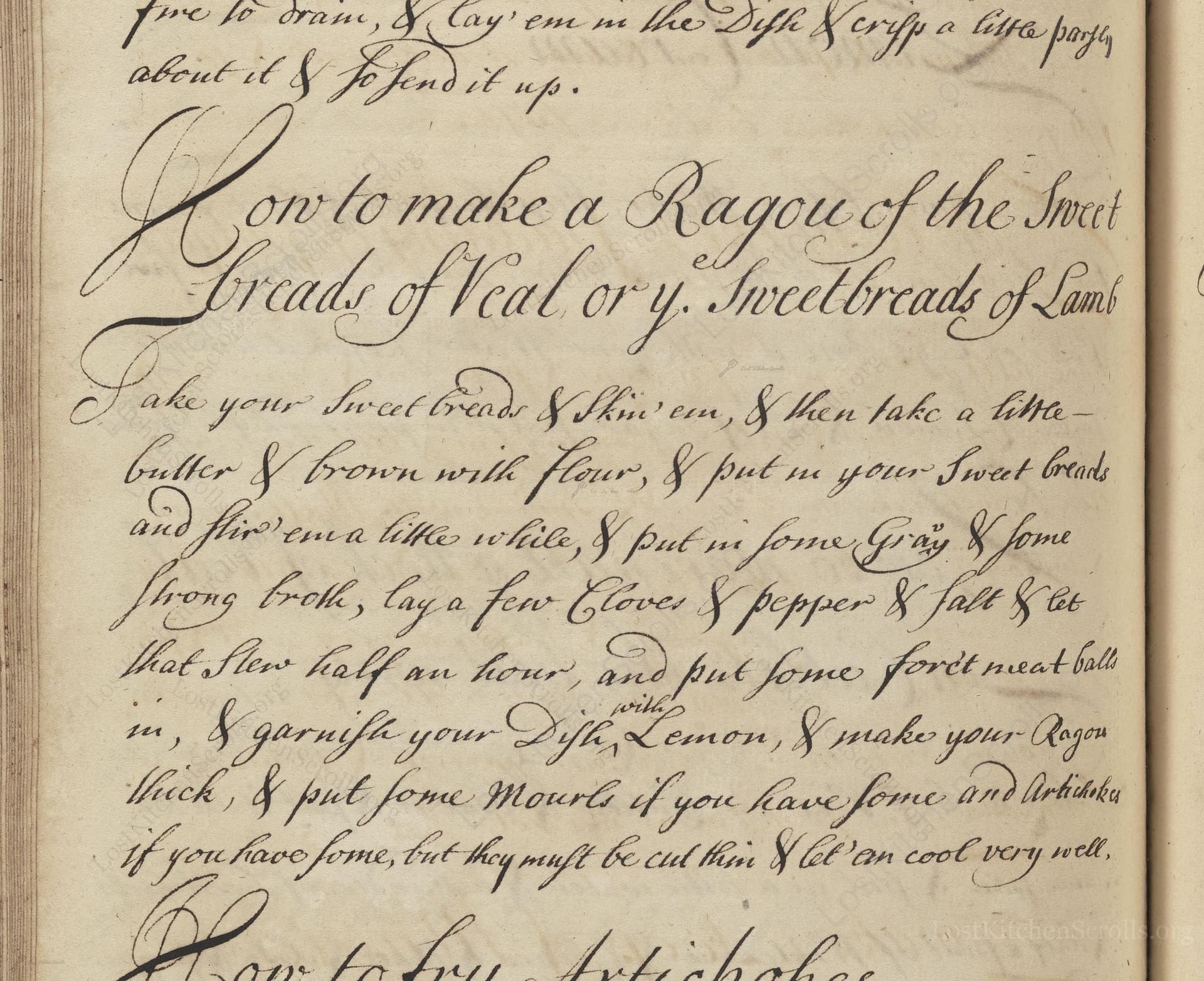How To Make A Ragou Of The Sweetbreads Of Veal Or Ye Sweetbreads Of Lambs
From the treasured pages of Various Cookeries
Unknown Author

How To Make A Ragou Of The Sweetbreads Of Veal Or Ye Sweetbreads Of Lambs
"Take your Sweetbreads & skin 'em, & then take a little butterr & brown with flour, & put in your Sweet breads and stir 'em a little while, & put in some Gray & some strong broth, lay a few Cloves & pepper & salt & let that stew half an hour, and put some forc't meat balls in, & garnish your Dish with Lemon, & make your Ragou thick, & put some Mourls if you have some and Artichokes if you have some, but they must be cut thin & let 'em cool very well."
Note on the Original Text
The recipe is written in the charmingly brisk and informal prose typical of the late 1600s. Spelling is variable (for example, 'forc't' for 'forced' or 'forcemeat', 'Mourls' for 'morels'), and instructions rely on the cook’s intuition and experience rather than precise measurements. There is little delineation between ingredients and method, and the recipe builds in sequence—adding elements as they become available, with little concern for weights or exact timings. This reflects the oral tradition of cookery, where specifics were learned by doing rather than reading.

Title
Various Cookeries (1690)
You can also click the book image above to peruse the original tome
Writer
Unknown
Era
1690
Publisher
Unknown
Background
A delightful glimpse into late 17th-century kitchens, this book brims with recipes, methods, and culinary wisdom passed down through generations, capturing the essence of historical gastronomy.
Kindly made available by
Folger Shakespeare Library
This recipe hails from late 17th-century England—a period when French culinary influence was beginning to make waves among the British gentry. Sweetbreads, a prized delicacy, were often featured in lavish ragouts—a term for a rich stew packed with morsels of luxury, like sweetbreads, mushrooms, and artichokes. Such dishes were enjoyed at banquets and formal meals, with many imported spices and garnishes to delight the sophisticated palate. Recipes like this would have been exchanged in manuscript form among wealthy households, each cook adapting and personalizing the dish to ingredient availability, making every ragout subtly unique.

Cooks in the 1600s would have used a heavy, lidded pot—likely made of brass, copper, or heavy earthenware—set directly over the hearth or on a trivet above hot coals. A long-handled spoon for stirring, a sharp knife for skinning the sweetbreads, and a mortar and pestle for crushing spices would all come into play. Serving would require a broad platter, often decorated with sliced citrus or herbs, transforming this rustic stew into a feast for the eyes as well as the palate.
Prep Time
20 mins
Cook Time
40 mins
Servings
4
We've done our best to adapt this historical recipe for modern kitchens, but some details may still need refinement. We warmly welcome feedback from fellow cooks and culinary historians — your insights support the entire community!
Ingredients
- 14 oz veal or lamb sweetbreads
- 2 tbsp (1 oz) unsalted butter
- 1 tbsp plain flour (about 1/3 oz)
- 2/3 cup rich beef or veal stock
- 3 tbsp dry white wine (optional)
- 3-4 whole cloves
- 1/4 teaspoon ground black pepper
- 1/4 teaspoon fine salt
- Forcemeat balls: 3.5 oz ground veal or chicken, 1 tbsp chopped herbs, 1 egg yolk, pinch of salt
- 1 oz morel mushrooms (or substitute with fresh button mushrooms if unavailable)
- 2 oz artichoke hearts, thinly sliced
- Lemon slices for garnish
Instructions
- Begin by taking about 14 ounces of veal or lamb sweetbreads and carefully removing any membrane or skin.
- In a heavy pan, melt 2 tablespoons (about 1 ounce) of unsalted butter and, when bubbling, whisk in 1 tablespoon (about 1/3 ounce) of plain flour to create a light roux.
- Add the sweetbreads and gently brown them, turning frequently.
- Pour in about 2/3 cup of a strong, rich beef or veal stock; add a splash (approximately 3 tablespoons) of dry white wine if you like.
- Season with a few whole cloves (3-4), a pinch (1/4 teaspoon) of ground black pepper, and a small pinch of salt.
- Cover and let simmer gently for 30 minutes, stirring now and then.
- Meanwhile, prepare some small forcemeat balls (e.g.
- seasoned ground veal or chicken with herbs and a little egg to bind).
- Add these to the ragout during the last 10 minutes.
- If available, throw in some sliced morel mushrooms (about 1 ounce) and artichoke hearts, thinly sliced (2 ounces), in the last few minutes.
- Stir until the sauce is thick and glossy.
- Serve on a platter garnished with lemon slices.
Estimated Calories
350 per serving
Cooking Estimates
You will spend about 20 minutes preparing the ingredients and another 40 minutes cooking. Each serving has about 350 calories. This recipe makes 4 servings.
As noted above, we have made our best effort to translate and adapt this historical recipe for modern kitchens, taking into account ingredients nowadays, cooking techniques, measurements, and so on. However, historical recipes often contain assumptions that require interpretation.
We'd love for anyone to help improve these adaptations. Community contributions are highly welcome. If you have suggestions, corrections, or cooking tips based on your experience with this recipe, please share them below.
Join the Discussion
Rate This Recipe
Dietary Preference
Main Ingredients
Culinary Technique

Den Bockfisch In Einer Fleisch Suppen Zu Kochen
This recipe hails from a German manuscript cookbook compiled in 1696, a time whe...

Die Grieß Nudlen Zumachen
This recipe comes from a rather mysterious manuscript cookbook, penned anonymous...

Ein Boudain
This recipe comes from an anonymous German-language manuscript cookbook from 169...

Ein Gesaltzen Citroni
This recipe, dating from 1696, comes from an extensive anonymous German cookbook...
Browse our complete collection of time-honored recipes



